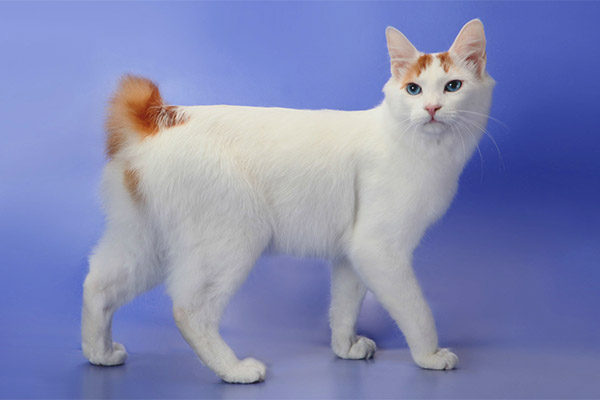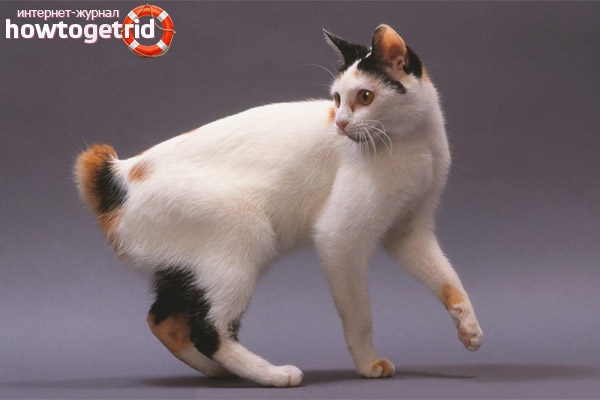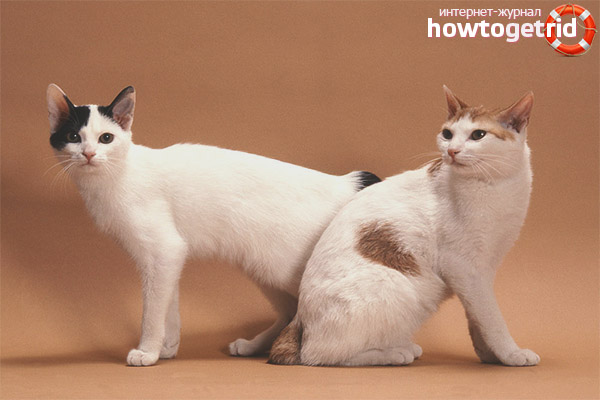The content of the article
- 1 Historical facts about the origin of the breed
- 2 Characteristics and features of the breed
- 3 Character traits
- 4 The content and health of the Japanese cat
- 5 Coloring features
- 6 At what price you can buy a kitten Japanese bobtail
- 7 Where can I buy a good luck symbol for you and your home?
- 8 Video: Japanese Bobtail
Japanese bobtail refers to the breed of short-tailed cats, which are revered in Japan. The Japanese have long believed that these cats bring happiness and luck to their dwelling house. Since ancient times, the inhabitants of this country believed that evil and failure are stored in the tail of a cat. Therefore, the shorter the tail, the less bad is stored and distributed in the host house. That is why these cats are not considered the keepers of evil, but on the contrary - they bring good and everything just good.
Historical facts about the origin of the breed
This breed appeared in ancient Japan. Even in millennial prescription in Japanese writing, these cats are mentioned that have short tails and attract good luck to the owner's house.In the fine art of the 15th century, you can also see graceful geishas surrounded by long-haired cats with fluffy tails and short-tailed cats. After all, the Japanese are very respectful of cats, there are many legends and will be associated with these affectionate animals.
Back in 1602, the Japanese emperor issued a decree - to release all domestic cats on the street in order to destroy rodents. At that moment, really a huge number of rodents caused a great loss to manufacturers and artisans. The Japanese understood their hopelessness in this situation, because the decree of the emperor was executed by every resident of Japan, without exception. However, having defeated the invasion of rodents, elite cats have already become street animals.
Only in 1968, this breed by seafarers was brought to North America, where it received its distribution with a view to its further official registration. In the 70s the short-haired bobtail was registered, and in the 90s - already the long-haired one. These certificates and to this day are an official document, despite the fact that absolutely no changes and innovations have been made to its specification.
Characteristics and features of the breed
This breed of cats is medium in size. Females reach 2.5 - 3.5 kg in weight, and cats - about 5 kg.
Characteristics of the breed generally accepted standard in accordance with the organization TICA:
- The head of the cat has the shape of a triangle equal on all sides, although it seems that the width and height are different.
- Soft outline of the head with elegant curves, raised cheekbones and pronounced features.
- Their muzzle is wide, at the bottom has a soft rounding.
- The eyes are large, oval-shaped, wide and attentive, it seems that cats are constantly on their guard. The eyes are sloped, which is very noticeable in profile.
- Their ears are large and expressive, they always stand erect, despite the fact that they have a wide landing, turned toward the center of the head, and not to the sides.
- The nose is clearly marked curly lines along the entire length, clearly stands out and has no cavities.
- They have a muscular, but thin body structure with a smooth back and a clear torso.
- Paws high, slender, corresponding to the structure of the whole body. The rear ones, like all representatives of the cat breed, are longer than the front ones, with a pronounced bend on the joint.
- These representatives of the tail can be straight, curled or bent - there is even a feeling that the tail is broken. The small tail is the main distinguishing feature of this breed of cats. The shape of each individual, as in humans, a fingerprint or strips on a zebra, the same does not happen. By the shape of the tail, you can always find out in what mood the animal is, if it is upright - then the pussy is relaxed. The maximum length of the tail, which happens in this breed of cats, does not exceed 12 centimeters.
- The coat is usually of medium length, visually identical smoothness, since the undercoat is not visible. However, the hair on the tail is noticeably longer and grows in the whole direction, the image of a dandelion is created. The hind legs may have a panties effect.
Character traits
The Japanese cat has a friendly disposition, it is a very dynamic and sensible type of cats. Above all, they have a fairly rich vocabulary - from a quiet affectionate or begging "meow" to a loud persistent and demanding meow.
Because of their activity, cats are very fond of various games, not only with their favorite toys, but also surrounded by people and even in water.Although the Japanese cat is a domesticated animal for a long time, it still easily lends itself to street walks on a leash, and it does not feel discomfort, and therefore its activity does not fade. Her high mental abilities contribute to the rapid learning of various tricks.
Due to the bone structure of the hind legs, kittens can jump high and far. These cats are restless, even when the animal is not involved in any game, it will definitely explore its environment. Sniff, look, and never be passive - they have already laid at the gene level. Even in the hands of the owner, affectionate, loyal cat will not sit for a long time. The friendly character helps them to live without problems in families where there are children or other animals.
The content and health of the Japanese cat
The shape and size of the tail of representatives of this breed laid at the genetic level. But the process of mutation no longer carries any other signs of change in the cat's body. For example, the mutation process in the Manks has a dynamic development - it strongly modifies the structure of the skeleton.Japanese handsome, however, is very resistant to various diseases, and the existing mutation does not cause any harm to the health of cats.
Kittens of this breed are born rather large, when compared with other breeds of cats. Therefore, the kittens are quite developed, they start to move, jump and learn early and explore everything and everyone around them. In specialized nurseries for the breeding of Japanese cats, kittens can be purchased as early as 3-4 months of their life.
Due to its activity, this breed of cats is never obese, so the daily diet should count: for one kilogram of cat weight - 80 kilocalories.
The treatment is traditional, nothing special. Absolutely like all cats - you need to clean your ears and eyes once a week, comb your wool even less often.
Coloring features
In the standard rules that are officially registered in relation to the breed, Japanese cats are allowed to have any color and their combinations, which are inherent in the cat family. The most valuable cats of this breed have bright colors and contrasting combinations.
According to the standard, they are distinguished by four criteria:
- tricolor Japanese cat, this color is also called mikay;
- fiery bright red color;
- pure snow white;
- and pitch black.
Eye color has a rich color range and is always in harmony with the color of the animal. But, quite often it is in the Japanese Bobtail breed that offspring with multi-colored eyes are born. Most often it is a combination of blue and yellow eyes. Most likely to get offspring with multi-colored eyes occurs when one of the parents has white color, since snow-white individuals are a standard feature at the chromosome level. Therefore, the most valuable species of this breed are snow-white kittens with eyes of different color. Accordingly, the cost of such kittens is much higher, because from this individual there will always be only disagreeable kittens, which is the main value for this breed.
At what price you can buy a kitten Japanese bobtail
Even if there are positive reviews about the seller, in any case it is impossible to judge the high characteristics of the kitten. Firstly, not every seller will be able to provide a certificate for a kitten, and secondly, a certificate is considered valid, which was registered by the official breeding nursery of the Japanese one-eyed handsome. After all, not only this breed of cats has eyes of different color. A mixture of any breeds, where the result is colored eyes and a docked tail - will not give such offspring at all. Moreover, the breed is really unique for its intellectual data and active lifestyle, which significantly distinguishes Japanese beauties from other breeds of cats.
Therefore, if you want a kind, affectionate kitty with a restless disposition and the same unique offspring in the future, then you should pay special attention to the documentation provided when buying a kitten.
Where can I buy a good luck symbol for you and your home?
It is very difficult to find an official Japanese bobtail breeding nursery in the states of the former CIS.But, if you go on the principle, and look for a truly real Japanese cat of this breed, then many happy owners of purebred animals are advised to contact the Yuki-Usagi kennel, which is in Japan. Although in Russia there is also an official nursery, which is called the Headquarters of Captain Rybnikov and is located in the Moscow periphery. There, it is guaranteed you can buy real Japanese bobtail with all officially confirming certificates.
In Belarus and Ukraine there are no official nurseries. There you can buy such a kitty only in private, which provides little likelihood to purchase a purebred bobtail.
Video: Japanese Bobtail













To send